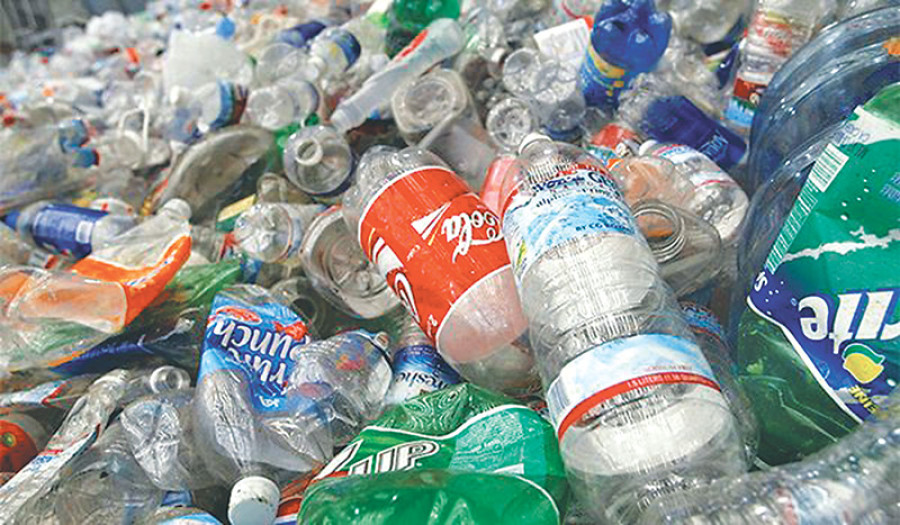Opinion
Eternal chokehold
Extensive efforts must be made to curb the use of lethal materials like plastic
Kedar Karki
Besides the radioactive waste produced by nuclear power plants, carbon monoxide, carbon dioxide and some other dangerous gases emitted due to the burning of hydrocarbon fuel, the next threat to our civilisation is from the continuous deposit of non-biodegradable plastic on the surface of the earth. The land, the sea surface, the sea bottom, the mountain valleys, or the poles—no region is now devoid of the presence of plastic.
Plastic, in its various forms, is limiting our time on earth by influencing various aspects of life. Many scientists and environmental specialists all over the world have studied the harmful effects of plastic in detail, and all of them are of the same view regarding the degree of harm they present. Apart from the introduction of many types of poisons into environment, plastic also blocks the sewage system of urban areas, adversely affects riverbeds and estuaries, and brings destructive changes in biodiversity.
Toxicity of plastic
Plastics are petroleum-based products, and they are used in various forms. The basic principle for the production of plastic is the conversion of natural gas or crude oil components into simple compounds, which are then bonded into chain like structures called polymers. Other chemicals added to the mix bring about different characteristics and properties to form different forms of plastic.
Low-density polyethylene is the form of plastic that is used for the production of polythene bags. High-density polyethylene is used for the production of buckets, bowls, cups, and plates, etc. Polyvinyl chloride is used for productions of Rexene shoe soles, toys, pipe, tubing blood and plasma transfusion bags etc. Polycarbonate is used to produce baby feeding bottles, large water bottles etc. The thermo-set polyurethane is used to produce all types of foams. Polypropylene is used to prepare packaging material for edible items, luggage carried and textile cones, polyethylene terephthalate is used to prepare bottles for many purposes.
All types of plastic require a huge amount of mineral oil for their production and transportation. So, the process of plastic synthesis causes a depletion of the earth’s fossil fuel reserve at a fast rate and produces dangerous chemicals. Polyutherane production accounts for the release of 11 percent of the total dangerous ‘phosgene’ gas released worldwide. There is always a chance for occupational hazards and the death of a large number of humans, animals and plants due to accidental leakage, and the plastic itself is also toxic; the key for their toxicity remains in the history of their production.
The building blocks of plastic polymer chains, the monomers, are themselves carcinogenic. The production of plastic is not entirely efficient, and some monomers remain in the final product. Besides these loose monomers, other toxic materials are also present in the plastic. Among them, materials used to colour plastics (mainly Lead and Cadmium based pigments) and other additives like formatting agents and plasticisers are toxic and most of them are carcinogenic as well. They all remain poorly bonded with the plastic polymers and tend to leach out and mix into the surrounding environment.
During burning, all types of plastic emit toxic gases, so burning is not viable to destroy the accumulated load of plastic on earth. Only a few types of plastic can be recycled in the process, it is hazardous to the health of the people who are engaged in the recycling process. During recycling, many toxic gases are emitted and the quality of the plastic deteriorates as the plastic is recycled over and over again. The process is also not economically feasible.
Threats to health
In the urban areas of our country, people throw materials like unused or rotten vegetables, uneaten food and snacks etc. after packing them with plastic packets in the garbage box. In many places, because of the absence of organised garbage disposals, there are pockets where these plastic packets of litter are deposited.
Animals are not able to distinguish plastic from straw and other cellulose containing materials. So it is not uncommon for the herbivorous animals, mainly cattle and buffaloes, and sheep and goats to consume plastic packets thinking them to be food.
These animals cannot digest this plastic and there is a continuous accumulation of such plastic packets inside the first camper of their four-chambered stomach. These plastic packets cause many problems. The vegetable or other materials inside the packets are not digested properly and most of the ingested plastic packets remain in the stomach along with the stagnated and decomposed feed particles inside it. Plastic cannot be digested, but the toxic materials of the plastic leak out and ultimately reach the blood stream of the animal.
After the accumulation of plastic packets in the stomach reaches a certain limit, the affected animal suffers acute tympany, which does not respond to any type of carminative or purgative drugs. The actual condition remains undiagnosed in almost all cases and the ultimate fate is death.
The absorption of lead and cadmium-based toxic colouring materials, additives and the toxic monomers of the plastic packet etc. not only causes toxicity in animals, it can even reach human tissues through the consumption of milk and meat. Continuous deposition of various medicinal drugs, agricultural insecticides and pesticides, poisonous adulterating chemicals, toxic preservatives and other colouring materials used in fast food items and various types of toxins together in the cellular level are dangerous and pose a great threat to mankind. As human beings are at the top of food chain, they ingest such drugs through consumption of food and food products made from meat, milk and eggs.
Karki is a veterinarian associated with the Shivaram Hatcheries and feed industries, Birgunj




 16.12°C Kathmandu
16.12°C Kathmandu










